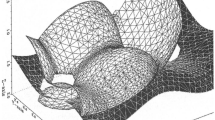Abstract
The seismic data quality can be improved by evaluating two aspects: seismic data acquisition and seismic imaging. In recent years, a number of innovative acquisition layouts and methods have been introduced that produced better subsurface images compare to previous dataset. However, the seismic technology in the industry has been largely on an ad-hoc basis without any qualitative analysis of the subsurface geology and complexity and its influence on data quality. In this chapter, the poor images beneath shallow gas cloud were analysed by using two types of illumination methods, namely wave propagation and ray interpolation techniques. Meanwhile the data enhancement methodology was conducted through optimization of receiver positions on surface level. This will address the issue of subsurface illumination below complex overburden and shallow anomaly that cause wave field distortion. The outcome from this work aims at developing the new technique of getting a good and reliable seismic data underneath the near surface anomaly by integrating the existing illumination techniques and optimizing the source and receiver positions. The proposed integrated method of illumination analysis, leads to a new attribute known as Illumination Factor (IF), was formulated based on information from two forward modelling methods; (i) Amplitude distribution in spatial domain and (ii) Ray hit count at the target subsurface. Evaluation of the proposed Illumination Factor will set a basis for improving seismic acquisition design, by enhancing seismic data through better illumination analysis while providing an insight for accurate reservoir characterization.
Access this chapter
Tax calculation will be finalised at checkout
Purchases are for personal use only
Similar content being viewed by others
References
Traynin, P., Liu, J., Reilly, J.M.: Amplitude and bandwidth recovery beneath gas zones using Kirchhoff prestack depth Q-migration. Presented at the SEG Annual Meeting, Las Vegas (2008)
Yongping, C., Yan, H.: Use Q-RTM to image beneath gas hydrates in Alaminos Canyon, Gulf of Mexico. Presented at the SEG Annual Meeting, Denver (2010)
Schuster, G.T.: Reverse-time migration = Generalized diffraction stack migration. Presented at the SEG Annual Meeting, Salt Lake City (2002)
Hill, N.R.: Gaussian beam migration. Geophysics 55, 1416–1428 (1990)
Gazdag, J.: Wave equation migration with phase-shift method. Geophysics 43, 1342–1351 (1978)
Moldoveanu, N., Egan, M.: Some aspects of survey design for wide-azimuth towed-streamer acquisition. In SEG Annual Meeting, San Antonio (2007)
Granli, J.R., Arnsten, B., Sollid, A., Hilde, E.: Imaging through gas-filled sediments using marine shear-wave data. Geophysics 64, 668–677 (1999)
Moldoveanu, N., Kapoor, J., Egan, M.: Full azimuth imaging using circular geometry acquisition. Lead. Edge 27, 908–913 (2008)
Berkhout, A.J., Blacquière, G.: Blended acquisition with dispersed source arrays, the next step in seismic acquisition? Presented at the SEG Annual Meeting, San Antonio (2011)
Berkhout, A.J.: The data-driven seismic value chain, providing a business context for the velocity issue. Geophys. Prospect. 52, 481–487 (2004)
Laurain, R., Gelius, L.J., Vinje, V., Lecomte, I.: A review of 3D illumination studies. J. Seism. Explor. 13, 17–37 (2004)
Berkhout, A.J., Ongkiehong, L., Volker, A.W.F., Blacquiere, G.: Comprehensive assessment of seismic acquisition geometries by focal beams Part I: theoretical considerations. Geophysics 66, 911–917 (2001)
Volker, A.W.F., Blacquiere, G., Berkhout, A.J., Ongkiehong, L.: Comprehensive assessment of seismic acquisition geometries by focal beams Part II: practical aspects and examples. Geophysics 66, 918–931 (2001)
Volker, A.W.F.: Assessment of 3D seismic acquisition geometries by focalbeam analysis. Ph.D., Applied Physics, Delft University of Technology (2002)
Van Veldhuizen, E.J.: Integrated approach to 3D seismic acquisition geometry analysis. Delft University of Technology, PhD (2006)
Vinje, V., Iversen, E., Gjoystdal, H.: Traveltime and amplitude estimation using wavefront construction. Geophysics 58, 1157–1166 (1993)
Gjøystdal, H., Iversen, E., Lecomte, I., Kaschwich, T., Drottning, Å., Mispel, J.: Improved applicability of ray tracing in seismic acquisition, imaging and interpretation. Geophysics 72, 261–271 (2007)
Cerveny, V., Molotrov, I.A., Psencik, I.: Ray method in seismology. Univerzita Karlova, Praha (1977)
Bernitsas, N.: Subsurface illumination, a hybrid wave equation-ray tracing method. United States Patent (2004)
Acknowledgements
The authors are grateful to all members of the Geoscience Department for their support and as well as the members of the above consultancy model’s team, which includes engineers, associate professors, lecturers, laboratory technologists, and students. Special thanks to the Universiti Teknologi PETRONAS, Malaysia for providing the permission and resources to carry out the laboratory demonstration. Without the kind cooperation this study would have been impossible.
Author information
Authors and Affiliations
Corresponding author
Editor information
Editors and Affiliations
Rights and permissions
Copyright information
© 2022 Institute of Technology PETRONAS Sdn Bhd
About this chapter
Cite this chapter
Abdul Latiff, A. (2022). Hybrid Illumination Analysis for Complex Overburden Geological Structure. In: Abdul Karim, S.A., Shafie, A. (eds) Towards Intelligent Systems Modeling and Simulation. Studies in Systems, Decision and Control, vol 383. Springer, Cham. https://doi.org/10.1007/978-3-030-79606-8_21
Download citation
DOI: https://doi.org/10.1007/978-3-030-79606-8_21
Published:
Publisher Name: Springer, Cham
Print ISBN: 978-3-030-79605-1
Online ISBN: 978-3-030-79606-8
eBook Packages: EngineeringEngineering (R0)



